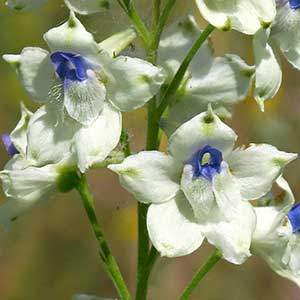Delphinium nuttallii subsp. ochroleucum
(synonym of Delphinium leucophaeum)
Delphinium geyeri
pale larkspur, white rock larkspur
Geyer's larkspur, poisonweed
30-60 cm.
(15-)30-60(-80) cm;
base usually reddish, puberulent.
blade light green, ± round, 1-5 × 1-6 cm, densely pubescent; ultimate lobes 7-20, width 2-5 mm (basal), 2-4 mm (cauline), apex gradually tapering to point;
veins obscure.
6-30(-60)-flowered, ± open, cylindric;
pedicel ascending to spreading, 1-3(-4) cm, puberulent;
bracteoles 1-3 mm from flowers, green, lanceolate, 3-6 mm, puberulent.
sepals white or light yellow, spurs 9-11 mm;
lower petal blades 4-6 mm.
sepals bright blue, puberulent, lateral sepals spreading, 10-18 × 4-8 mm, spurs straight to slightly downcurved, ascending 0-30°, 11-16 mm;
lower petal blades slightly elevated, ± exposing stamens, 4-8 mm, clefts 0.5-2 mm;
hairs centered, densest on inner lobes near base of cleft, white to light yellow.
11-15 mm, 3-3.5 times longer than wide, sparse puberulent.
unwinged;
seed coat cells with margins straight, surfaces ± roughened.
= 16.
= 16.
Delphinium nuttallii subsp. ochroleucum
Delphinium geyeri
Of conservation concern.
The range of morphologic features of Delphinium nuttallii subsp. ochroleucum (D. leucophaeum) is almost completely encompassed within that of D. nuttallii subsp. nuttallii. Sepal color is the only feature consistently separating the two subspecies. Were it not for the fact that any given population typically has plants of only one flower color, a rank of forma would be more appropriate.
(Discussion copyrighted by Flora of North America; reprinted with permission.)
Apparently closely related to Delphinium stachydeum, D. geyeri is generally smaller, earlier flowering, with more finely dissected leaves and a more eastern geographic distribution.
(Discussion copyrighted by Flora of North America; reprinted with permission.)


